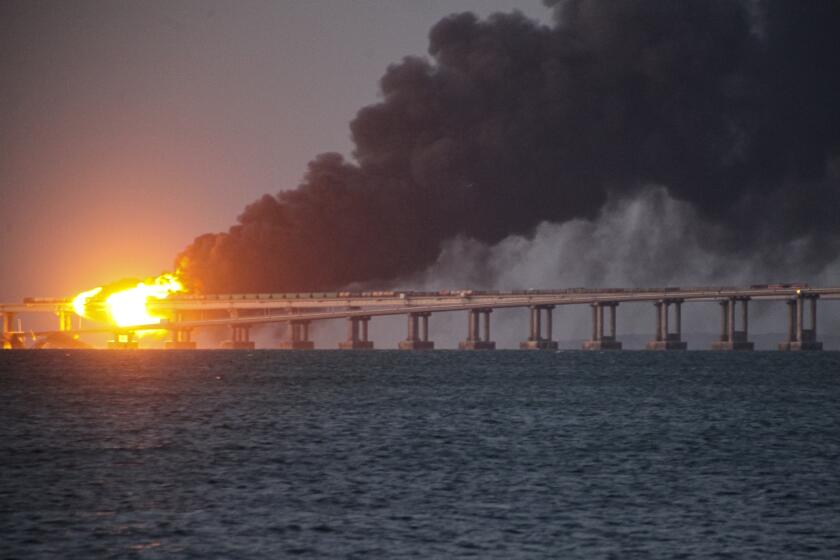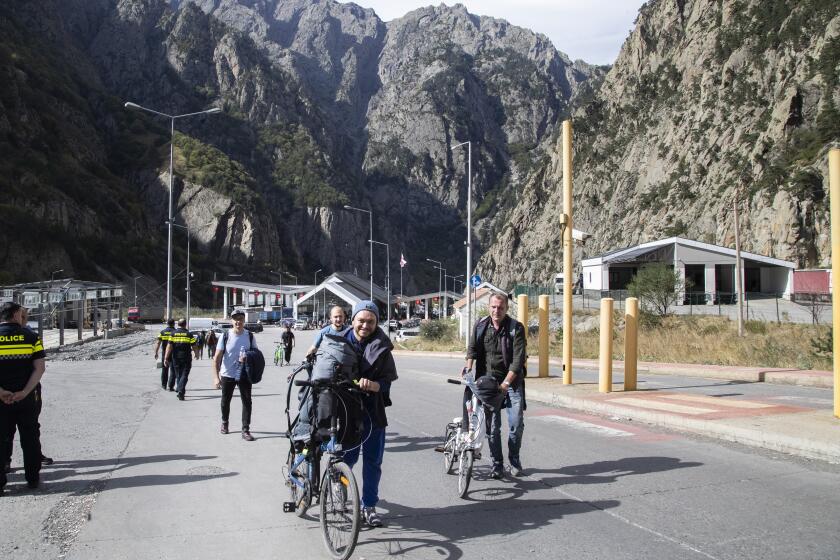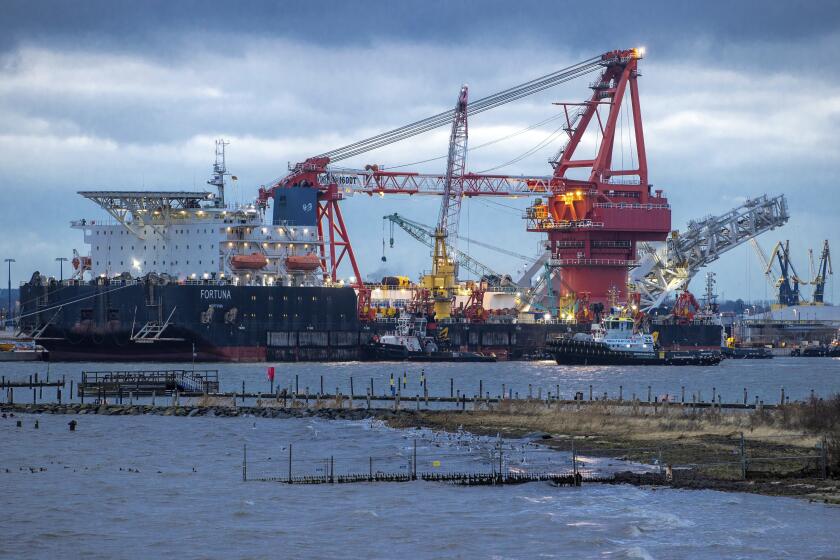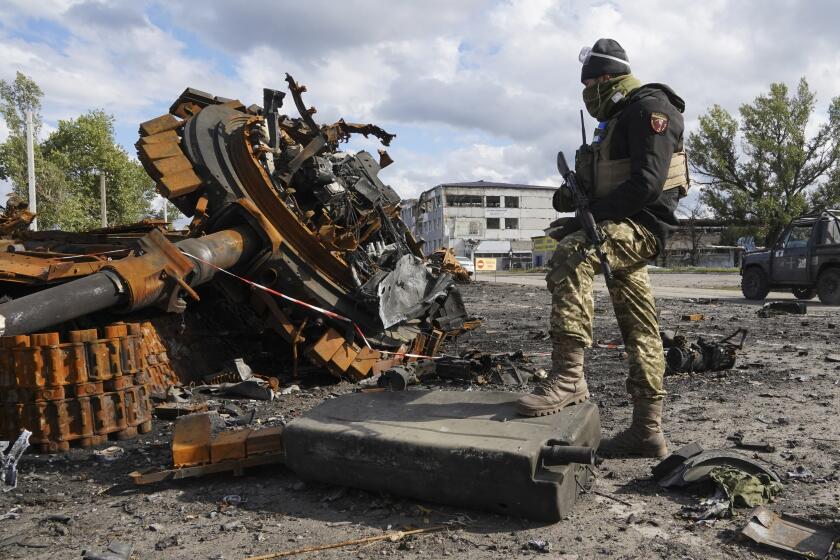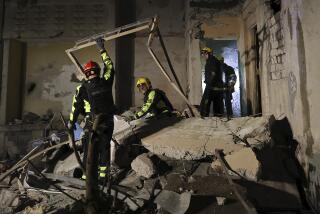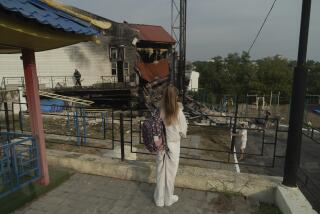Kyiv hit by ‘kamikaze drones’ as Russia keeps up broad assault in Ukraine
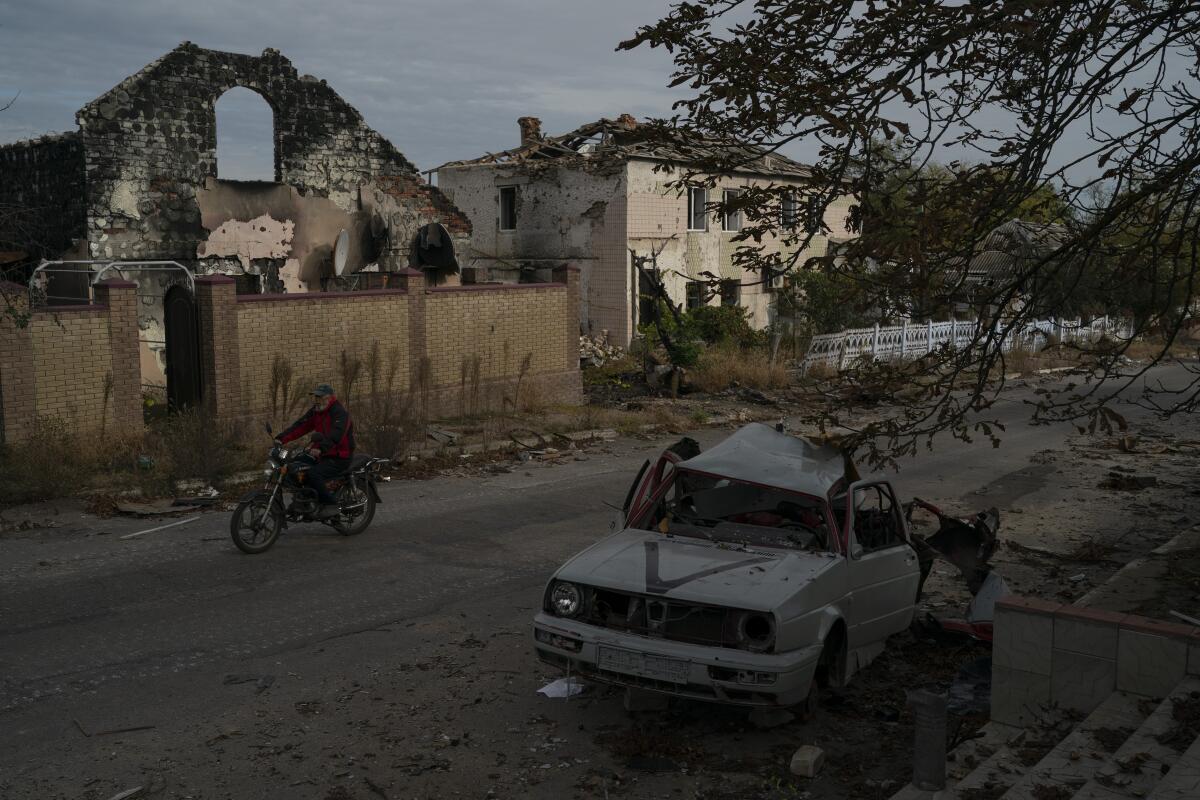
KYIV, Ukraine — Russian forces used Iranian-made kamikaze drones to attack Ukraine’s capital and Odesa regions Thursday and slammed other areas with missiles as Moscow punished the country for a fourth day for a bomb attack on a landmark bridge connecting Russia with the annexed Crimean peninsula.
A strike carried out near Makrariv, a small city about 30 miles west of Kyiv, destroyed critical infrastructure. Throughout the capital region, residents whose lives had resumed some normality when the war moved east months ago again awoke to air-raid sirens.
The intensity of Russia’s attacks on civilian areas has increased in recent weeks as its military lost ground in multiple occupied regions of Ukraine that President Vladimir Putin illegally claimed as Russian territory. Putin’s supporters urged him to escalate the campaign further after the Crimea bridge attack.
It wasn’t clear whether the explosive-packed drones caused any casualties. Ukrainian officials said dozens of people died this week after the Russian military ramped up the scope of its attacks, including at least two killed Thursday in a missile strike that destroyed an apartment building in southern Ukraine.
Ukrainian officials said Thursday that Iranians in Russian-occupied territories of Ukraine were training Russians how to use the Shahed-136 drone systems, which can conduct air-to-surface attacks, electronic warfare and targeting. Their deployment may indicate that the Russian military is running out of its own drones.
The low-flying aerial devices help keep Ukraine’s cities on edge, but the British Defense Ministry has said the Iran-made drones were unlikely to be fulfilling their purpose of providing strike options deep into Ukrainian territory, with many reportedly destroyed before they hit their targets.
Moscow’s barrage of missile strikes on cities across Ukraine has elicited celebratory comments from Russian officials and pro-Kremlin pundits.
Ukraine’s air force command said Thursday that it had shot down six Iranian drones over the Odesa and Mykolaiv regions during the night.
Russia resumed widespread attacks in Ukraine on Monday following the explosion that damaged the Kerch Bridge. The 12-mile-long bridge carries military supplies to Ukraine and is important as a symbol of Russia’s power.
The speaker of Russia’s lower house of parliament Thursday said Russian forces struck more than 70 energy facilities in Ukraine this week and threatened an “even tougher” response to future attacks by “the Kyiv regime,” although Ukraine has not publicly claimed responsibility for the bridge bombing.
“All the organizers and perpetrators of the terrorist attacks must be found; those who resist must be destroyed,” State Duma speaker Vyacheslav Volodin wrote on Telegram.
In numbers comparable to the size of Putin’s 300,000-strong mobilization, Russian men are fleeing military call-up. Not everyone welcomes them.
Russian officials said Thursday that Ukrainian forces shelled Russia’s Belgorod region, which borders Ukraine. According to the region’s Gov. Vyacheslav Gladkov, the shelling damaged a multistory residential building in the city of Belgorod, while a projectile that landed on a school sports ground did not explode.
Putin said the massive barrage of missile strikes across Ukraine that started Monday was carried out in retaliation for what he called Kyiv’s “terrorist” actions targeting the Kerch Bridge. Putin vowed a “tough” and “proportionate” response to Ukrainian attacks that he said threatened Russia’s security.
Kyiv was hit at least four times during Monday’s massive strikes, which killed at least 19 people and wounded more than 100 across the country.
Russian forces have made early-morning attacks a daily occurrence in southern Ukraine as the Ukrainian military wages a counteroffensive aimed at recapturing occupied areas.
The war in Ukraine and Russia’s willingness to cut off gas exports have left European countries scrambling to find alternative sources of energy.
In the southern city of Mykolaiv, overnight shelling destroyed a five-story apartment building as fighting continued along Ukraine’s southern front. Mykolaiv regional Gov. Vitaliy Kim said that an 11-year-old boy was rescued from under the rubble, where he had spent six hours, and rescuers Thursday morning were searching for seven more people.
Kim said the building was hit by an S-300 missile, a weapon ordinarily used for targeting military aircraft, but Russian forces have apparently been increasingly using them for imprecise ground strikes.
Some NATO member states this week pledged to send more weapons to Ukraine, including air-defense systems and weapons Kyiv has said are critical to defeating the invading Russian forces.
Britain said Thursday that it would provide missiles for advanced NASAM anti-aircraft systems that the Pentagon plans to send to Ukraine in coming weeks. It’s also sending hundreds of additional aerial drones for information-gathering and logistics support, plus 18 more howitzer artillery guns.
As Russia’s military performance weakens, a notorious mercenary group, long part of the Ukraine fight, steps into spotlight.
British Defense Secretary Ben Wallace said that “these weapons will help Ukraine defend its skies from attacks and strengthen their overall missile defense alongside the U.S. NASAMS.”
The systems, which Kyiv has long wanted, will provide medium- to long-range defense against missile attacks.
The pledge came as NATO defense ministers led a meeting in Brussels of the Western military alliance’s secretive Nuclear Planning Group. NATO plans to hold a nuclear exercise next week amid concerns over Putin’s insistence that he would use any means necessary to defend Russian territory, including the illegally annexed regions of Ukraine.
NATO is keeping a wary eye on Russia’s movements, but has so far seen no change in its nuclear posture. Russia is expected to hold its own nuclear exercises soon, possibly at the same time as NATO or just after, according to NATO diplomats.
Breaking News
Get breaking news, investigations, analysis and more signature journalism from the Los Angeles Times in your inbox.
You may occasionally receive promotional content from the Los Angeles Times.
Putin met Thursday with Turkish President Recep Tayyip Erdogan on the sidelines of a regional summit in Astana, Kazakhstan. United Nations officials had expressed hope a day earlier that the meeting would lead to an extension of agreements that led to the resumption of Ukrainian grain exports and Russian fertilizer exports.
“We are determined to transport Russia’s grain and fertilizer to underdeveloped countries through Turkey,” Erdogan said, adding that Ankara and Moscow could jointly designate the countries the products would go to.
The war in Ukraine has created food shortages and price increases by slowing shipments of agricultural products.
More to Read
Sign up for Essential California
The most important California stories and recommendations in your inbox every morning.
You may occasionally receive promotional content from the Los Angeles Times.
